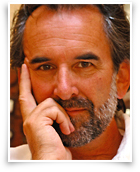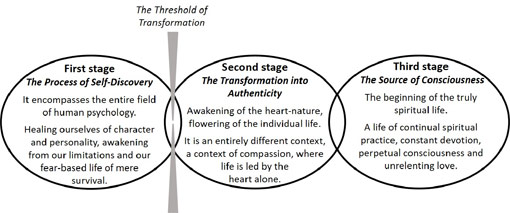
Richard Harvey
connecting psychotherapy and spiritual growth for human awakening
The Three Stages of Awakening
The expanded, holistic view has led me to a three—tiered model of total human potential, capacity, and development that I have come to call The Three Stages of Human Awakening. It lays the foundation for a divine psychology by bringing together the wisdom of the ancients with the deep insights of psycho—spirituality from the twentieth century.
Each stage is distinct from the others and progressively they chart the path of human development and possibility, a way to become fulfilled and embrace the fullness of human experience, to reach beyond death, to timeless peace.
The Three Stages of Awakening is also a response to the confusion and lack of inspiration in the fields of human psychology and spirituality. My model separates personal psychology or early life conditioning from spiritual processes and proposes an intermediate stage of authenticity and transformation, in which the individual experiences the authentic flowering of their natural self. The third stage is the beginning of serious spiritual practice and the development of transcendent processes leading to ultimate, divine radiance and Self—realization.

The first stage encompasses the entire field of human psychology as it has been expressed and developed over thousands of years around the world and over the last hundred years. Significantly, I have added a full stop to human psychology, which is tantamount to heresy and will no doubt invite ridicule and disdain from the establishment. The heresy is my assertion that personal psychotherapy not only can end, but that we should build this idea of ending into the therapeutic model to enable human beings to truly grow, develop, and become empowered.
Thus, the first awakening we can have is to awaken from our character or fear—based life of mere survival. It is especially important, as mere survival has become the ambition and the aim of most people, due to childhood trauma. Childhood trauma not only includes spectacular, explicit, extreme scenarios of physical, sexual, verbal, and violent abuse, neglect and damage, it also describes assaults to our sensitivity, humiliation, shaming, not feeling wanted and cared for, or loved in a wise and feeling way. Trauma also involves not being allowed to grow and develop naturally, not learning about boundaries, personal power, sexuality and personal understanding of the world, our relationship to it and our role within it. In response to these challenges, the resourcefulness of the child is extraordinary. Western psychology has refined a highly sophisticated typology for understanding all the various permutations of character defenses through which we defend ourselves in childhood and early years. The mix and the inflections make each person’s individual defense strategy unique. It is overwhelming in its intricacy and it is remarkably effective in giving protection. In parallel with the rise of individualism and the creation of a society in which individuals consider themselves primary, self—sacrifice, deferring gratification, identifying ourselves with a belief system or as a member of a family, a community, or a group have become dominant features of Western (increasingly global Western—influenced) culture and society.
Regardless of whether you consider yourself traumatized by life or not, you have become familiar with your life through a mask of patterned behavior, both inner and outer, which is essentially mechanistic. You may be charming, polite, likeable, talented, charismatic, able, handsome, beautiful, or dependable; nonetheless your behavior has been refined unconsciously over years of adaptation.
In parallel, your true nature, your essence, is gradually fading untilit ends up “disappearing”. It seems that we must retain the essence we carry at all costs. So, we take the necessary steps and then perplexingly, we forget. This phenomenon is curious, we simply forget. As I stated earlier, this is the step which is like burying a treasure chest and then throwing away the key and forgetting the entire process of burying it. We know neither where or how or why we did it. In some sense we don’t even know who did it!
How tremendously wise! For if you really want to conceal something, to hide it safely away, what better method than to forget it ever existed. This treasure, this essence is the true Self, the self—nature, the essential core being, and due to early life experience – or trauma – it must be protected at all costs. How wise then to conceal it so well. The person you become, from that time on, is counterfeit, inauthentic, merely defensive, clandestinely aggressive, completely false – a persona, a mechanism of behaviors, masquerading in a mummer’s costume, an actor or a puppet.
When we look for disciplines of psychological inner work from ancient times to the early twentieth century, although the groundwork is laid, there is no substantial understanding, no penetrative analysis for contemporary humanity. The Upanishads, the Vedanta, the Ebers Papyrus of ancient Egypt, Plato’s Republic – some of the oldest manuals of inner work, methodology and philosophy there are – cannot help us. But look at the last 100 years of Western psychology – the modern period of individualism has given birth to egocentricity, as well as the means to understand and combat the illness that has developed in parallel with its cure.
So we have created a world, a life, an existence. We have created a reality limited to survival, in which nothing but our continuing existence is fundamentally prized or expected. A world in which the lower energy concerns of fight or flight, of foraging for love, of growing toward impossible security is the highest, most elevated goal. Our relationships to the other, to the world, is damaged, wounded beyond repair, beyond hope and beyond trust, through animosity, insensitivity, insecurity, pain, and discomfort. Healing ourselves of character and personality is central to the first stage of human awakening – a process through which the fundamental attachments to ego—processes are released
So the first stage of human awakening is like climbing out of the box, releasing yourself from all of your limiting assumptions about yourself and your life, and shedding the basic fear of survival in the physical body. By association, it is letting go of the deepest fear, which is the fear of not existing. This fear is based on separation and separation is based on division and identifying as a divided self. So first stage awakening involves shedding this identification, the one that says I am purely ego, I am separate from you, am in the world. In practice this entails dismantling your character defenses and personality, releasing yourself from restrictive living, and embracing the responsibility of personal authenticity.
Therefore, in this first stage of awakening, we also shed our attachments to automatic behavior, gestures and tendencies, along with deeper emotional behavioral patterns. We become less fearful, less sentimental, less automatic, and in time we come to the great threshold of aliveness and vibrancy, the Threshold of Transformation where we meet a void, one final test… and we leap.
Seeking is the anathema of the truly spiritual search, but it is the key to the first stage of awakening – seeking, seeking, seeking for yourself, finding out who you are, who you really are, shedding the mask, letting go of your attachment to your façade, the persona, and undermining all your complex character defense strategies that impose limits, control suffering, and prevent you living a full and happy, creative, loving life.
The second stage of human awakening is the way of compassion or the flowering of the individual life and it is predicated on the heart—filled existence. This has been to some extent documented in the lives of saints, so it is subject to a distancing effect. Religion and an exalted view of others who are seen as “special” has prevented us from understanding that the heart—filled life of authenticity and compassion does not have to be considered as unattainable purity, but as a personal challenge to our becoming and actualizing an innate potential. In other words, each of us has the inner capacity to realize ourselves through the true heart by living the life of surrender and devotion. The second level of awakening is the life of the heart and you attain it by crossing the Threshold of Transformation into authenticity. This event is unique for everybody but easily identifiable by anyone who has crossed it or by you yourself after you have crossed. Beginning second—level awakening is only possible after you have achieved the state of inner wholeness. It comes after reaching the profoundest depth of inner work. In the second stage of awakening we are centrally concerned with the mystery of the other. We are persistently inclined toward the experience of undiscerning compassion, because the life of the heart is all—inclusive. It is likely that Life as your teacher will bring challenges to the heart, people who are hard to love, situations that are hard to bear, in order to free you of further deeper attachments.
This stage is not only of great importance for individual fulfillment, but it is also crucial to collective humanity, which in the modern era is struggling to care and is presently incapable of true compassion. We will come back to this stage later in more detail.
The third stage is the beginning of the truly spiritual life, which we are not legitimately qualified (this by natural law, not by an earthbound edict) to begin, until we are free of our basic attachments to both inner and outer expressions of personality and character patterns and behavior. The third stage is the outcome of all that has gone before and more. We embark on spiritual practice as sadhana, perpetual rather than part—time discipline, constant devotion as the apotheosis of love, and perpetual consciousness as the consummation of awareness.
(Adapted from Harvey, Richard, Your Divine Opportunity: how to awaken to your true self in the modern era, Part II: Turning Toward the Divine Life, 31—33, Sacred Attention Publishing 2021.
Full details and ordering at
https://www.therapyandspirituality.com/books/)
Share this article
This article was published on this site in December 2020